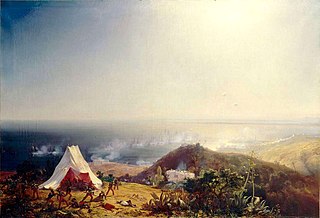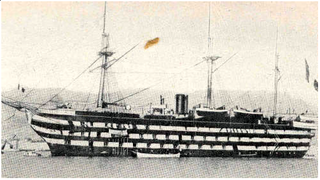 Loss of a longboat of Algésiras in a storm, 9 August 1831. | |
| History | |
|---|---|
| Name: | Algésiras |
| Namesake: | Battle of Algeciras |
| Ordered: | 20 February 1812 |
| Builder: | Lorient |
| Laid down: | 1 April 1812 |
| Launched: | 21 August 1823 |
| In service: | 20 August 1828 |
| Struck: | 1846 |
| General characteristics | |
| Class and type: | Bucentaure-class |
| Type: | ship of the line |
| Length: |
|
| Beam: | 15.27 m (50.10 ft) |
| Depth of hold: | 7.63 m (25.03 ft) |
| Propulsion: | Sail |
| Sail plan: | 2,683 m2 (28,879.57 sq ft) |
| Complement: | 866 |
| Armament: |
|
The Algésiras was an 80-gun Bucentaure-class 80-gun ship of the line of the French Navy, designed by Sané.

A ship of the line was a type of naval warship constructed from the 17th through to the mid-19th century to take part in the naval tactic known as the line of battle, in which two columns of opposing warships would manoeuvre to bring the greatest weight of broadside firepower to bear. Since these engagements were almost invariably won by the heaviest ships carrying the most powerful guns, the natural progression was to build sailing vessels that were the largest and most powerful of their time.

The French Navy, informally "La Royale", is the maritime arm of the French Armed Forces. Dating back to 1624, the French Navy is one of the world's oldest naval forces. It has participated in conflicts around the globe and played a key part in establishing the French colonial empire.

Jacques-Noël Sané was a French naval engineer. He was the conceptor of standardised designs for ships of the line and frigates fielded by the French Navy in the 1780s, which served during the French Revolutionary Wars and the Napoleonic Wars and in some cases remained in service into the 1860s. Captured ships of his design were commissioned in the Royal Navy and even copied.
She took part in the Invasion of Algiers in 1830, under Captain Ponée, and in the Battle of the Tagus the next year, under Captain Moulac.

The Invasion of Algiers in 1830 was a large-scale military operation by which the Kingdom of France, ruled by Charles X, invaded and conquered the Ottoman Regency of Algiers. Algiers had been a province of the Ottoman Empire since the Capture of Algiers in 1529 by Hayreddin Barbarossa.

The Battle of the Tagus was a naval engagement that took place on 11 July 1831 at the mouth of the Tagus river, in Portugal. A French fleet attacked and subdued Portuguese fortifications at the entrance of the Tagus, with the aim to strong-arm the government of Miguel I into recognising the newly established Kingdom of the French. The damage to the forts defending access to the Tagus and the arrival of French warships at Lisbon forced the Portuguese to cave in and comply with French demands.
Vincent-Marie Moulac was a French naval officer and privateer.
In 1832, she was used as a troopship to ferry troops to Algeria. In 1836, she cruised the Caribbean with Artémise.

The Artémise was a 60-gun frigate of the French Navy, designed by Jean-Baptiste Hubert.
Algésiras was featured in Les Misérables , where she is mislabeled as a frigate:

Les Misérables is a French historical novel by Victor Hugo, first published in 1862, that is considered one of the greatest novels of the 19th century. In the English-speaking world, the novel is usually referred to by its original French title. However, several alternatives have been used, including The Miserables, The Wretched, The Miserable Ones, The Poor Ones, The Wretched Poor, The Victims and The Dispossessed. Beginning in 1815 and culminating in the 1832 June Rebellion in Paris, the novel follows the lives and interactions of several characters, particularly the struggles of ex-convict Jean Valjean and his experience of redemption.
| “ | The frigate Algesiras was anchored alongside the Orion, and the poor convict had fallen between the two vessels Book second, chapter III | ” |










